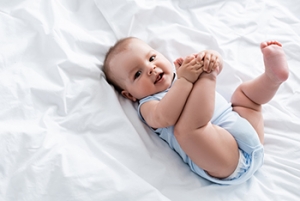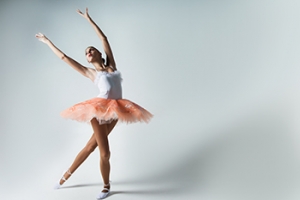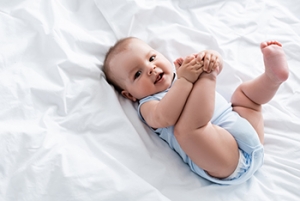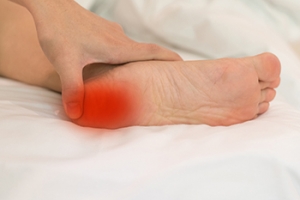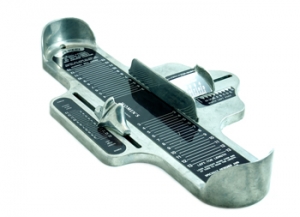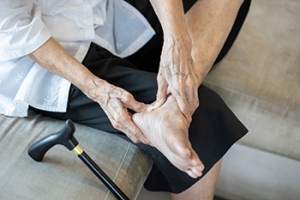Super User
Poor Circulation in Babies

It is said that an individual has poor circulation in the feet when there is less blood flowing to the feet. As a result, individuals might feel any range of symptoms such as cold feet, a pins and needles feeling, or pain and achiness. Many parents of newborn babies often have many questions about whether and to what extent their baby might be experiencing any kind of poor circulation in the feet. For example, sometimes baby’s feet might experience poor circulation and turn a slight purple shade as a result. Interestingly, it is not always a serious sign if a baby exhibits some degree of reduced circulation in the feet. However, it is always best to consult with a health professional like a podiatrist, especially if your baby demonstrates a blue-ish tongue, which may be a more serious sign of an underlying problem. Schedule an appointment with a podiatrist today for more information about your baby’s foot health.
While poor circulation itself isn’t a condition; it is a symptom of another underlying health condition you may have. If you have any concerns with poor circulation in your feet contact Dr. Anna Petrov of Family Foot & Ankle Care. Our doctor will treat your foot and ankle needs.
Poor Circulation in the Feet
Peripheral artery disease (PAD) can potentially lead to poor circulation in the lower extremities. PAD is a condition that causes the blood vessels and arteries to narrow. In a linked condition called atherosclerosis, the arteries stiffen up due to a buildup of plaque in the arteries and blood vessels. These two conditions can cause a decrease in the amount of blood that flows to your extremities, therefore resulting in pain.
Symptoms
Some of the most common symptoms of poor circulation are:
- Numbness
- Tingling
- Throbbing or stinging pain in limbs
- Pain
- Muscle Cramps
Treatment for poor circulation often depends on the underlying condition that causes it. Methods for treatment may include insulin for diabetes, special exercise programs, surgery for varicose veins, or compression socks for swollen legs.
As always, see a podiatrist as he or she will assist in finding a regimen that suits you. A podiatrist can also prescribe you any needed medication.
If you have any questions, please feel free to contact one of our offices located in Wheeling and Chicago, IL . We offer the newest diagnostic and treatment technologies for all your foot care needs.
How Dancers Stretch Their Feet
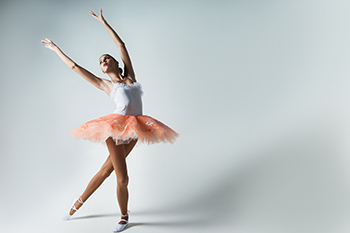
Stretching the feet, no matter who you are or how frequently you engage in physical activity, can be beneficial for a number of different reasons. However, if you are a dancer, then stretching the feet can be all the more important and necessary. There are several different explanations for this phenomenon. By stretching the feet, a dancer is essentially building strength in their feet. This ultimately helps a dancer better handle the significant physical demands of dancing. Ballet, for example, is a particular kind of dance that is highly demanding on the feet. Therefore, ballet dancers stand to benefit to a great degree by stretching their feet. If you are a dancer looking to strengthen their feet through stretches and exercises, consider performing a hand towel or thera-band stretch. Contact a podiatrist today for more information about stretching the feet.
Stretching the feet is a great way to prevent injuries. If you have any concerns with your feet consult with Dr. Anna Petrov from Family Foot & Ankle Care. Our doctor will assess your condition and provide you with quality foot and ankle treatment.
Stretching the Feet
Being the backbone of the body, the feet carry your entire weight and can easily become overexerted, causing cramps and pain. As with any body part, stretching your feet can serve many benefits. From increasing flexibility to even providing some pain relief, be sure to give your feet a stretch from time to time. This is especially important for athletes or anyone performing aerobic exercises, but anyone experiencing foot pain or is on their feet constantly should also engage in this practice.
Great ways to stretch your feet:
- Crossing one leg over the others and carefully pull your toes back. Do 10-20 repetitions and repeat the process for each foot
- Face a wall with your arms out and hands flat against the wall. Step back with one foot and keep it flat on the floor while moving the other leg forward. Lean towards the wall until you feel a stretch. Hold for 30 seconds and perform 10 repetitions for each foot
- Be sure not to overextend or push your limbs too hard or you could risk pulling or straining your muscle
Individuals who tend to their feet by regular stretching every day should be able to minimize foot pain and prevent new problems from arising.
If you have any questions, please feel free to contact one of our offices located in Wheeling and Chicago, IL . We offer the newest diagnostic and treatment technologies for all your foot care needs.
Stretching Your Feet
Debilitating foot pain is a problem for many people. But just as stretching the torso can help alleviate back pain, stretching the feet can also help mend existing foot problems and prevent future ones.
The feet, as the body’s foundation, carry the body’s entire weight and can get easily strained from overexertion. Persistent sharp pain and cramping in the feet are often common concerns. Foot pain and foot problems can be due to any number of causes, and in many cases pain may be eased without medication or doctor visits. It is always a good idea, however, to first rule out any serious medical issues with a physician.
Stretching can help relax the feet and alleviate pain, but is especially important before heavy aerobic exercise. Stretching before such activities can help you avoid experiencing painful cramps or strained foot muscles. Stretches should be performed slowly and deliberately without forceful pulling. The stretch should be held for several seconds before relaxing.
A great way to stretch out and loosen up the foot muscles while sitting is to cross one leg over the other and pull the toes carefully back without overextending. Start by resting the left ankle on the right knee. With the left hand, gently flex the left foot by pulling back on the toes. Do not pull too hard; just hard enough to feel the stretch in the arch of the foot. Then point the toes of the left foot as far as you can. Rotate the motion of pointing with pulling back on the toes. This should relax and stretch the muscles on the bottom and the top of the foot. Doing this stretch ten to twenty times should bring relief. Repeat the whole process for the other foot by resting the right ankle on the left knee.
A stretch that focuses on the often injured Achilles tendon involves standing and facing a wall with your arms out and hands flat against the wall. Step back with one foot, keeping it flat against the floor. Move the other leg forward and lean toward the wall. You should feel a stretch through the back of your leg and your Achilles tendon, but do not push yourself too much. Stop when you feel a stretching sensation, and hold for 30 seconds. Ten repetitions may be done for each foot.
Stretching the feet is important for athletes or those performing aerobic exercise, but it can also help anyone with foot pain caused by poor footwear, plantar fasciitis, or long hours standing and walking. Individuals who tend to their feet by regularly stretching every day should be able to minimize foot pain and prevent new problems from arising.
Caring for Baby’s Feet

Baby’s feet are adorable and can melt your heart. Their feet are mostly made up of fatty tissue and are generally soft and pliable. At first baby’s feet may appear blue, wrinkled, and peeling, but as soon as a baby gets warm, their feet will become pink and fill out. It is important to care for a baby’s feet to make them strong enough for when they start walking. Their feet should be clean and clear of infection. Their feet should be allowed to grow, develop, and strengthen naturally. Wash and dry a baby’s feet daily. Sprinkle them with baby powder to assure they stay dry. Cut toenails straight across to ensure they do not grow into the skin. Make sure the baby has enough space to move their feet around, without being restricted. Exercise their feet by tickling their feet a bit so they can flex and stretch them. Have them wear socks versus shoes so movement is free. Examine the baby’s feet to make sure problems are not brewing. See a podiatrist for a proper evaluation and treatment if you see something amiss with your baby's feet.
The health of a child’s feet is vital to their overall well-being. If you have any questions regarding foot health, contact Dr. Anna Petrov of Family Foot & Ankle Care. Our doctor can provide the care you need to keep you pain-free and on your feet.
Tips for Keeping Children's Feet Healthy
- Make sure their shoes fit properly
- Look for any signs of in-toeing or out-toeing
- Check to see if they have Clubfoot (condition that affects your child’s foot and ankle, twisting the heel and toes inward) which is one of the most common nonmajor birth defects.
- Lightly cover your baby’s feet (Tight covers may keep your baby from moving their feet freely, and could prevent normal development)
- Allow your toddler to go shoeless (Shoes can be restricting for a young child’s foot)
- Cut toenails straight across to avoid ingrown toenails
- Keep your child’s foot clean and dry
- Cover cuts and scrapes. Wash any scratches with soap and water and cover them with a bandage until they’ve healed.
If you have any questions, please feel free to contact one of our offices located in Wheeling and Chicago, IL . We offer the newest diagnostic and treatment technologies for all your foot care needs.
Veins and Spider Veins in the Feet
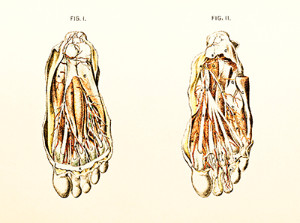
The feet are complex parts of the human body that are made up of a series of different bones, muscles, tendons, and ligaments. Importantly, the feet also contain veins, which are blood vessels that return old blood to the heart. Sometimes, a condition known as spider veins may develop in the feet. Spider veins essentially develop when many different small veins gather together beneath the skin. As a result, the veins can be visible on the surface of the skin, and they might be red, blue, or purple in color. Luckily, spider veins are mostly harmless to those that develop them. In addition to the feet, spider veins can also develop on the lower legs . If you are someone that wants to learn more about the veins of the feet and particularly how spider veins develop, contact a podiatrist today.
If you have any concerns about your feet, contact Dr. Anna Petrov from Family Foot & Ankle Care. Our doctor can provide the care you need to keep you pain-free and on your feet.
Biomechanics in Podiatry
Podiatric biomechanics is a particular sector of specialty podiatry with licensed practitioners who are trained to diagnose and treat conditions affecting the foot, ankle and lower leg. Biomechanics deals with the forces that act against the body, causing an interference with the biological structures. It focuses on the movement of the ankle, the foot and the forces that interact with them.
A History of Biomechanics
- Biomechanics dates back to the BC era in Egypt where evidence of professional foot care has been recorded.
- In 1974, biomechanics gained a higher profile from the studies of Merton Root, who claimed that by changing or controlling the forces between the ankle and the foot, corrections or conditions could be implemented to gain strength and coordination in the area.
Modern technological improvements are based on past theories and therapeutic processes that provide a better understanding of podiatric concepts for biomechanics. Computers can provide accurate information about the forces and patterns of the feet and lower legs.
Understanding biomechanics of the feet can help improve and eliminate pain, stopping further stress to the foot.
If you have any questions please feel free to contact one of our offices located in Wheeling and Chicago, IL . We offer the newest diagnostic and treatment technologies for all your foot and ankle needs.
Active Children and Sever’s Disease
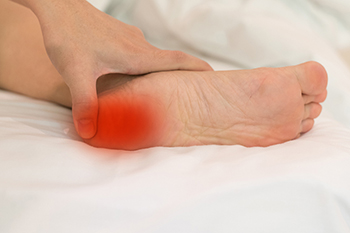
The foot condition that is known as Sever’s disease can affect children and young teenagers who participate in running and jumping activities. It is considered to be an ailment that comes from overuse in and around the growth plate in the heel. The child may complain of having heel pain, and can have difficulty in walking. A podiatrist can perform a proper diagnosis, which consists of having a physical examination done, in addition to learning about the child's choice of activities. The child will eventually outgrow Sever’s disease, and until then, mild relief can be found when the activity that caused this condition is temporarily stopped. Patients may also find that it helps to elevate the affected foot as often as possible, and it may be beneficial to wear a heel pad in the shoe. It is strongly suggested that your child sees a podiatrist at the first sign of heel pain, so a proper diagnosis can be performed, and the correct treatment can promptly begin.
Sever's disease often occurs in children and teens. If your child is experiencing foot or ankle pain, see Dr. Anna Petrov from Family Foot & Ankle Care. Our doctor can treat your child’s foot and ankle needs.
Sever’s Disease
Sever’s disease is also known as calcaneal apophysitis, which is a medical condition that causes heel pain I none or both feet. The disease is known to affect children between the ages of 8 and 14.
Sever’s disease occurs when part of the child’s heel known as the growth plate (calcaneal epiphysis) is attached to the Achilles tendon. This area can suffer injury when the muscles and tendons of the growing foot do not keep pace with bone growth. Therefore, the constant pain which one experiences at the back of the heel will make the child unable to put any weight on the heel. The child is then forced to walk on their toes.
Symptoms
Acute pain – Pain associated with Sever’s disease is usually felt in the heel when the child engages in physical activity such as walking, jumping and or running.
Highly active – Children who are very active are among the most susceptible in experiencing Sever’s disease, because of the stress and tension placed on their feet.
If you have any questions, please feel free to contact one of our offices located in Wheeling and Chicago, IL . We offer the newest diagnostic and treatment technologies for all your foot and ankle injuries.
Women Often Wear Shoes That Are Too Small
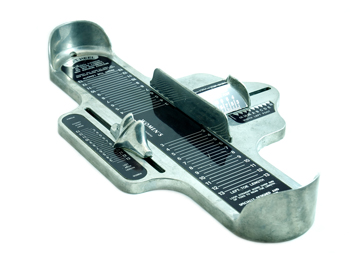
It is odd, but factual, that women often wear the wrong shoe size and in most cases, their shoes are too short or narrow. When their feet are measured, they often react with denial that their feet have changed as they have “always worn the same size.” When checking shoe fit, one should allow at least half an inch between the big toe and the front part of the shoe. The pinky toe should not push against the side of the shoe. Women are more apt to prefer pointier toe boxes, instead of round ones. It might be OK if a woman’s feet are narrow, but if they are medium to extra wide, wearing such shoes can be painful and cause conditions like ingrown toenails, bunions, or hammertoes. The truth is that foot's shape and shoe size change over time. Some things that contribute to a change in shoe size are pregnancy, aging, and weight gain or loss. Over time, feet can get longer and wider because arches decrease, and the foot flattens and lengthens. If you are experiencing foot pain, it might be helped by simply having your feet measured and wearing a half-inch size larger shoe. Consult with a podiatrist who can properly measure your feet and discuss how you might better approach thinking about shoe size.
Getting the right shoe size is an important part of proper foot health. Seek the assistance of Dr. Anna Petrov from Family Foot & Ankle Care. Our doctor will provide the care you need to keep you pain-free and on your feet.
Getting the Right Shoe Size
There are many people who wear shoes that are the incorrect size, negatively affecting their feet and posture. Selecting the right shoes is not a difficult process, so long as you keep several things in mind when it comes to choosing the right pair.
- When visiting the shoe store, use the tools available to measure your foot.
- Be sure there is ‘wiggle room’. There should be about an inch between your toes and the tip of your shoes.
- Do not always assume you are the same size, as manufacturers run differently.
- Purchase shoes later in the day, as your feet swell as the day progresses.
- If a shoe is not comfortable, it is not suitable. Most shoes can’t be ‘broken in’, and comfort should be the ultimate goal when it comes to choosing the right pair of shoes
As our feet hold our body weight and keep us moving, it is important to treat them right. Picking the right pair of shoes can provide your feet comfort and mobility without pain.
If you have any questions, please feel free to contact one of our offices located in Wheeling and Chicago, IL . We offer the newest diagnostic and treatment technologies for all your foot care needs.
Getting the Right Shoe Size
If you want to ensure the long-term health of your feet, you should choose the right pair of shoes to wear on an everyday basis. Poorly fitting shoes will not only be uncomfortable, but they may also cause foot pain and unwanted foot conditions. When looking for a new pair of shoes, there are certain factors you should look for.
One of the most crucial tips you can follow is to always try shoes on in the afternoon. It is normal for feet to swell throughout the day, which means your shoe size may be different in the morning compared to what it is at night. To be safe, you should go with the slightly bigger size to ensure that your feet have enough room within your shoes.
Another rule is to never buy shoes that are too tight (Many people buy shoes that are too tight for their feet and expect the shoes to stretch out). If you are looking for a pair of running sneakers, you can go to a specialty running shoe store to have your feet properly sized. When you purchase shoes in-store, walk around in them to make sure the shoes you are going to buy fit you properly. Take some time to make sure the shoes are comfortable for your feet
The upper section of your shoe should be made from a softer, more flexible material. The material that makes up the shoe should not be slippery. Arch support should be a key factor in the decision-making process for shoes. Arch support is crucial because it will prevent the arches in your feet from collapsing. If your arches collapse, the plantar fascia may begin to stretch out which could lead to plantar fasciitis.
Many problematic foot conditions may be prevented by wearing properly fitting shoes. Some of these unwanted conditions are bunions, corns, calluses, pain, stress fractures, and plantar fasciitis. If you are suffering from any of these ailments you may want to speak with your podiatrist.
Potential Foot Conditions That May Affect Seniors
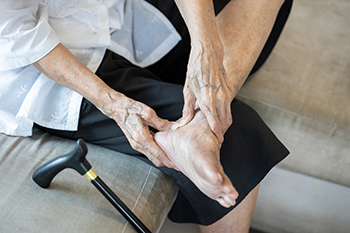
There are several reasons why elderly people may encounter foot problems. The fat pads in the feet may become thinner, and the skin may be drier. Severely cracked heels that are known as fissures may develop, and relief can come from using a good moisturizer. Many seniors have poor circulation, which may lead to the inability to feel existing cuts or wounds on the feet. One of the best things elderly people can do for their feet is to wear shoes and socks that fit correctly. Research has shown the feet become wider as the aging process occurs, and larger shoes may need to be purchased. It may be beneficial to lose extra weight which may help to prevent heel spurs and plantar fasciitis from developing. This is helpful in reducing the pressure the heels endure from completing daily activities. It is suggested that elderly people are under the regular care of a podiatrist who can identify potential foot problems, and offer effective prevention and treatment tips.
Proper foot care is something many older adults forget to consider. If you have any concerns about your feet and ankles, contact Dr. Anna Petrov from Family Foot & Ankle Care. Our doctor can provide the care you need to keep you pain-free and on your feet.
The Elderly and Their Feet
As we age we start to notice many changes in our body, but the elder population may not notice them right away. Medical conditions may prevent the elderly to take notice of their foot health right away. Poor vision is a lead contributor to not taking action for the elderly.
Common Conditions
- Neuropathy – can reduce feeling in the feet and can hide many life-threatening medical conditions.
- Reduced flexibility – prevents the ability of proper toenail trimming, and foot cleaning. If left untreated, it may lead to further medical issues.
- Foot sores – amongst the older population can be serious before they are discovered. Some of the problematic conditions they may face are:
- Gouging toenails affecting nearby toe
- Shoes that don’t fit properly
- Pressure sores
- Loss of circulation in legs & feet
- Edema & swelling of feet and ankles
Susceptible Infections
Diabetes and poor circulation can cause general loss of sensitivity over the years, turning a simple cut into a serious issue.
If you have any questions please feel free to contact one of our offices located in Wheeling and Chicago, IL . We offer the newest diagnostic and treatment technologies for all your foot and ankle needs.
The Less Common High Ankle Sprain
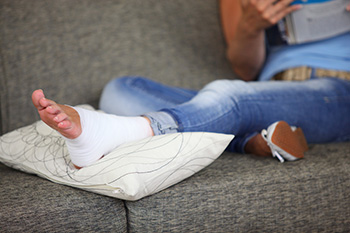
A high ankle sprain involves the ligaments and shin bones, which are located above the ankle. It is defined as the tearing or stretching of these ligaments, and it can cause severe pain and discomfort. Additionally, ankle stability may be affected from potential damage that can happen to the surrounding tendons and muscles. An ankle sprain can occur as a result of twisting the ankle beyond its normal range of motion, which can happen from unexpectedly stepping off of a curb. People who have endured a high ankle sprain generally feel pain when the foot is flexed upward, such as in climbing the steps. The ankle can feel weak, and walking may be difficult. An X-ray is necessary to help determine if the ankle is sprained or fractured. The squeeze test is also an effective method of detecting a high ankle sprain, which is performed by squeezing the patient’s leg under the knee. If a high ankle sprain is present, it may cause pain to radiate down to the ankle. If you have experienced an ankle sprain, please contact a podiatrist who can begin an effective treatment method.
Although ankle sprains are common, they aren’t always minor injuries. If you need your ankle injury looked at, contact Dr. Anna Petrov from Family Foot & Ankle Care. Our doctor can provide the care you need to keep you pain-free and on your feet.
How Does an Ankle Sprain Occur?
Ankle sprains are the result of a tear in the ligaments within the ankle. These injuries may happen when you make a rapid shifting movement while your foot is planted. A less common way to sprain your ankle is when your ankle rolls inward while your foot turns outward.
What Are the Symptoms?
- Pain at the sight of the tear
- Bruising/Swelling
- Ankle area is tender to touch
- In severe cases, may hear/feel something tear
- Skin discoloration
Preventing a Sprain
- Wearing appropriate shoes for the occasion
- Stretching before exercises and sports
- Knowing your limits
Treatment of a Sprain
In many cases, the RICE method (Rest, Ice, Compression, and Elevate) is used to treat ankle sprains. However, you should see a podiatrist to see which treatment option would work best with your injury. In severe cases, surgery may be required.
It is important to ask your doctor about rehab options after you receive treatment for your injury. Stretching, strength training, and balance exercises may help the ankle heal while also preventing further injury.
If you have any questions, please feel free to contact one of our offices located in Wheeling and Chicago, IL . We offer the newest diagnostic and treatment technologies for all your foot care needs.



